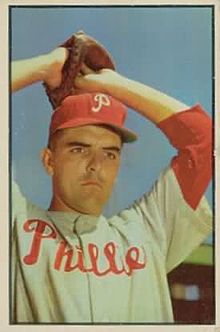sport.wikisort.org - Athlete
Curtis Thomas Simmons (born May 19, 1929) is an American former professional baseball left-handed pitcher, who played in Major League Baseball (MLB) from 1947 to 1950 and 1952 to 1967. Along with right-hander Robin Roberts (a member of the Baseball Hall of Fame), Simmons was one of the twin anchors of the starting rotation of the "Whiz Kids", the Philadelphia Phillies' 1950 National League (NL) championship team. He also played for the St. Louis Cardinals, Chicago Cubs, and California Angels.
This biography of a living person needs additional citations for verification. (August 2022) |
| Curt Simmons | |
|---|---|
 | |
| Pitcher | |
| Born: May 19, 1929 Whitehall Township, Pennsylvania | |
Batted: Left Threw: Left | |
| MLB debut | |
| September 28, 1947, for the Philadelphia Phillies | |
| Last MLB appearance | |
| October 1, 1967, for the California Angels | |
| MLB statistics | |
| Win–loss record | 193–183 |
| Earned run average | 3.54 |
| Strikeouts | 1,697 |
| Teams | |
| |
| Career highlights and awards | |
| |
Biography
Early life and education
Simmons was born in Whitehall Township, Pennsylvania in the Lehigh Valley region of eastern Pennsylvania. He attended Whitehall High School, where he led Whitehall to three straight league titles and also led the Coplay American Legion team to two Pennsylvania state crowns.[1]
Major League Baseball career
In 1947, then Philadelphia Phillies owner Bob Carpenter arranged for an exhibition match between his Phillies and a team of all-star high school players from the Lehigh Valley. The game was played on the opening day of Egypt Memorial Park in front of a crowd of 4,500. Simmons struck out eleven and the game ended in a 4–4 tie (a late-game error was the only thing that prevented the high school team from winning). The 5 ft 11 in (1.80 m), 175 lb (79 kg) lefty was signed by the Phillies, and awarded a $65,000 signing bonus (one of the highest ever awarded at that time).[1] That spring, Simmons also pitched and played outfield in an All-American high school game between teams managed by Babe Ruth and Ty Cobb. In 1949, Simmons returned to the Lehigh Valley, pitching for the Phillies in an exhibition match (a game won by a 10–3 margin) against the Allentown Redbirds, in front of a record crowd of 4,590 at Whitehall's Breadon Field.
Simmons won 17 of 25 decisions during the 1950 season, playing a role in bringing Philadelphia its second National League (NL) championship of the 20th century. With the outbreak of the Korean War, however, Simmons was called to active military service in September 1950, with only a month remaining in the campaign. The Phillies managed to hold off the Brooklyn Dodgers in the 1950 season's final contest (on Dick Sisler's 10th-inning home run) to win the NL flag by two games. Simmons was stationed at Camp Atterbury and requested and was granted a leave on October 4, 1950 to attend the Series. The Phillies chose not to request that the Commissioner of Baseball Happy Chandler rule Simmons eligible for the Series, but Simmons chose to attend to support the team. Simmons' place on the Series roster was taken by pitcher Jocko Thompson.[2] Without Simmons, the Phillies were swept in four games by Joe DiMaggio and the New York Yankees.
Simmons missed the entire 1951 season while in the military, but he returned in 1952 to win 14 games, posting a 2.82 earned run average (ERA) and leading Major League Baseball with six shutouts. The team would never again contend for a championship during his tenure there, although Simmons continued to pitch into the late 1950s. In 1959, he was struck with a sore arm, and in 1960, the Phillies, then in last place and in rebuilding mode, released him on May 17, 1960, after four mound appearances. Simmons signed as a free agent with the St. Louis Cardinals three days later, and began a comeback that culminated in 15- and 18-game-winning seasons in 1963 and 1964, respectively, while in a pitching rotation that included Bob Gibson and Ray Sadecki. In 1964, he appeared in the World Series against the New York Yankees. He started two games for the eventual world champion Cardinals, losing his only decision but compiling a 2.51 ERA.
Simmons’ last winning record was in 1964; he lost 15 games for St. Louis in 1965, then finished his career with the Chicago Cubs and California Angels, in 1966 and 1967. His final record, over 20 years, was 193–182 (.515). In 569 games pitched and 3,3481⁄3 innings, Simmons allowed 3,313 hits and 1,063 bases on balls. He recorded 1,697 strikeouts, 163 complete games, 36 shutouts, and five saves. Along with Smoky Burgess, Simmons was the last player to formally retire who had played in MLB in the 1940s (not counting Minnie Miñoso, who would later un-retire, twice). MLB Hall of Fame hitters Hank Aaron[3] and Stan Musial[4] each separately named Simmons as the toughest pitcher they had to face in their careers.
References
- Bostrom, Don (April 10, 2008). "Phils hadn't played here in six decades". Morning Call.[permanent dead link]
- "Curt Simmons Given Leave For Series". Toledo Blade. 1950-10-04. p. 33.
- John, Andrew L. (February 14, 2016). "Hank Aaron, Bud Selig speak at Indian Wells fundraiser". The Desert Sun. Retrieved 22 May 2017.
- Kunda, John (May 21, 1991). "The Hall's Yearbook Has It All". The Morning Call. Retrieved 22 May 2017.
External links
- Career statistics and player information from MLB, or ESPN, or Baseball Reference, or Fangraphs, or Baseball Reference (Minors), or Retrosheet
- Curt Simmons at SABR (Baseball BioProject)
- Curt Simmons at Baseball Almanac
- Curt Simmons at Baseballbiography.com
Другой контент может иметь иную лицензию. Перед использованием материалов сайта WikiSort.org внимательно изучите правила лицензирования конкретных элементов наполнения сайта.
WikiSort.org - проект по пересортировке и дополнению контента Википедии
